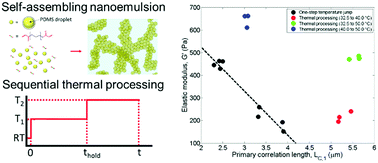当前位置:
X-MOL 学术
›
Soft Matter
›
论文详情
Our official English website, www.x-mol.net, welcomes your feedback! (Note: you will need to create a separate account there.)
Thermal processing of thermogelling nanoemulsions as a route to tune material properties†
Soft Matter ( IF 3.4 ) Pub Date : 2018-06-20 00:00:00 , DOI: 10.1039/c8sm00814k Li-Chiun Cheng 1, 2, 3, 4 , P. Douglas Godfrin 1, 2, 3, 4 , James W. Swan 1, 2, 3, 4 , Patrick S. Doyle 1, 2, 3, 4
Soft Matter ( IF 3.4 ) Pub Date : 2018-06-20 00:00:00 , DOI: 10.1039/c8sm00814k Li-Chiun Cheng 1, 2, 3, 4 , P. Douglas Godfrin 1, 2, 3, 4 , James W. Swan 1, 2, 3, 4 , Patrick S. Doyle 1, 2, 3, 4
Affiliation

|
Many soft matter systems have properties which depend on their processing history. It is generally accepted that material properties can be finely tuned by carefully directing self-assembly. However, for gelling colloidal systems, it is difficult to characterize such path-dependent effects since the colloidal attraction is often provided by adding another component to the system such as salts or depletants. Therefore, studies of and an understanding of the role of processing on the material properties of attractive colloidal systems are largely lacking. In this work, we systematically studied how processing greatly influences the properties and the microstructures of model attractive colloidal systems. We perform experiments using a thermogelling nanoemulsion as a model system where the isotropic attraction can be precisely tuned via the temperature. The effects of processing conditions on gel formation and properties is tested by performing well-designed sequential temperature jumps. By properly controlling the thermal history, we demonstrate that properties of colloidal gels can be beyond the limit set by direct quenching, which has been a major focus in literature, and that otherwise slow aging of the system associated with a decrease in elasticity can be prevented. Our results provide new experimental evidence of path-dependent rheology and associated microstructures in attractive colloidal systems and provide guidance to future applications in manufacturing complex colloid-based materials.
中文翻译:

热胶凝纳米乳液的热处理作为调节材料性能的途径†
许多软物质系统具有取决于其处理历史的属性。人们普遍接受的是,可以通过仔细指导自组装来对材料特性进行微调。然而,对于胶凝胶体系统,很难表征这种依赖于路径的效应,因为胶体吸引通常是通过向系统中添加另一种成分(例如盐或贫化剂)来提供的。因此,非常缺乏对有吸引力的胶体系统的材料特性的加工作用的研究和了解。在这项工作中,我们系统地研究了加工过程如何极大地影响模型吸引性胶体系统的性质和微观结构。我们使用热凝胶纳米乳液作为模型系统进行实验,可以精确调整各向同性的吸引力通过温度。通过执行精心设计的连续温度跳变来测试加工条件对凝胶形成和性能的影响。通过适当地控制热历史,我们证明了胶体凝胶的性质可以超出直接淬火设定的极限,这是文献中的主要重点,否则可以防止与弹性降低相关的系统缓慢老化。我们的结果提供了有吸引力的胶体系统中依赖于路径的流变学和相关微结构的新实验证据,并为将来在制造复杂的基于胶体的材料中的应用提供了指导。
更新日期:2018-06-20
中文翻译:

热胶凝纳米乳液的热处理作为调节材料性能的途径†
许多软物质系统具有取决于其处理历史的属性。人们普遍接受的是,可以通过仔细指导自组装来对材料特性进行微调。然而,对于胶凝胶体系统,很难表征这种依赖于路径的效应,因为胶体吸引通常是通过向系统中添加另一种成分(例如盐或贫化剂)来提供的。因此,非常缺乏对有吸引力的胶体系统的材料特性的加工作用的研究和了解。在这项工作中,我们系统地研究了加工过程如何极大地影响模型吸引性胶体系统的性质和微观结构。我们使用热凝胶纳米乳液作为模型系统进行实验,可以精确调整各向同性的吸引力通过温度。通过执行精心设计的连续温度跳变来测试加工条件对凝胶形成和性能的影响。通过适当地控制热历史,我们证明了胶体凝胶的性质可以超出直接淬火设定的极限,这是文献中的主要重点,否则可以防止与弹性降低相关的系统缓慢老化。我们的结果提供了有吸引力的胶体系统中依赖于路径的流变学和相关微结构的新实验证据,并为将来在制造复杂的基于胶体的材料中的应用提供了指导。



























 京公网安备 11010802027423号
京公网安备 11010802027423号